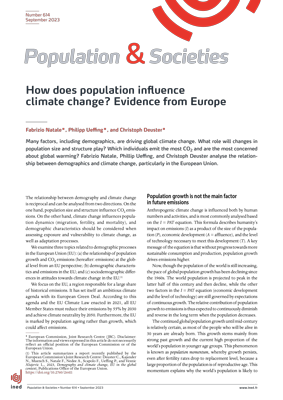How does population influence climate change? Evidence from Europe
Press release Published on 25 September 2023

Authors: Fabrizio Natale (European Commission, Joint Research Centre-JRC), Phillip Ueffing (European Commission, Joint Research Centre-JRC) and Christoph Deuster (European Commission, Joint Research Centre-JRC)
Many factors, including demographics, are driving global climate change. What role will changes in population size and structure play? Which individuals emit the most CO2 and are the most concerned about global warming? Fabrizio Natale, Phillip Ueffing, and Christoph Deuster analyse the relationship between demographics and climate change, particularly in the European Union.
The European Union has committed to achieving climate neutrality by 2050. Globally, population growth will persist, even after fertility decreases. This momentum implies that the major potential for global CO2 emissions reduction until mid-century lies not in the size of the population but in the greening of the economy of the EU and of other major emitters.
At the European level, findings show that emissions increase with age until the age of 75. Given population ageing, the share of emissions attributable to older individuals should increase in the years to come.
Similar to emission profiles, attitudes towards climate change are affected by sociodemographic characteristics. Younger individuals, those with higher levels of education, and residents of large towns are more likely to say that climate change is the most serious or a very serious problem. For example, the share of individuals aged 15–29 who believe it is the most serious problem is 5 percentage points larger than that of respondents older than 60. Similarly, while only around 10% of individuals with a primary level of education select climate change as the foremost problem, this share rises to more than 25% for those with a tertiary education.
Individual behaviour and attitudes towards climate change are shaped markedly by sociodemographic characteristics, such as education, age, and place of residence. Policies for climate action should take them into account.
Disclaimer: The information and views expressed in this article do not necessarily reflect an official position of the European Commission or of the European Union.
Published on: 27/09/2023








